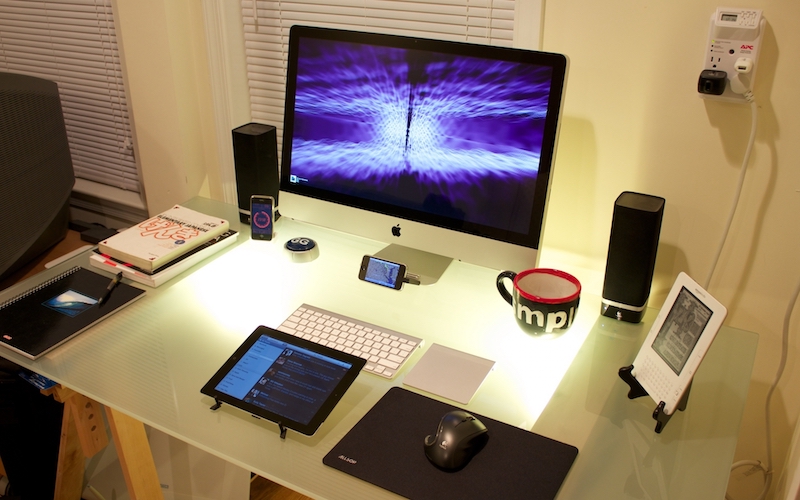




Computer platforms
Nog een item
Nog een item
Lorem Ipsum is slechts een proeftekst uit het drukkerij- en zetterijwezen. Lorem Ipsum is de standaard proeftekst in deze bedrijfstak sinds de 16e eeuw, toen een onbekende drukker een zethaak met letters nam en ze door elkaar husselde om een font-catalogus te maken. Het heeft niet alleen vijf eeuwen overleefd maar is ook, vrijwel onveranderd, overgenomen in elektronische letterzetting. Het is in de jaren '60 populair geworden met de introductie van Letraset vellen met Lorem Ipsum passages en meer recentelijk door desktop publishing software zoals Aldus PageMaker die versies van Lorem Ipsum bevatten.

Amiga
Amiga
The Amiga is a family of personal computers introduced by Commodore in 1985. The original model was part of a series of 16/32- and 32-bit computers that featured 256 KB or more of RAM, mouse-based GUIs, and significantly improved graphics and audio over 8-bit systems. This wave included the Atari ST—released the same year—Apple's Macintosh, and later the Apple IIGS. Based on the Motorola 68000 microprocessor, the Amiga differed from its contemporaries through the inclusion of custom hardware to accelerate graphics and sound, including sprites and a blitter, and a pre-emptive multitasking operating system called AmigaOS.
The Amiga 1000 was released in July 1985, but a series of production problems kept it from becoming widely available until early 1986. The best selling model, the Amiga 500, was introduced in 1987 and became one of the leading home computers of the late 1980s and early 1990s with four to six million sold.[1] The A3000 was introduced in 1990, followed by the A500+, and the A600 in March 1992. Finally, the A1200 and the A4000 were released in late 1992. The platform became particularly popular for gaming and programming demos. It also found a prominent role in the desktop video, video production, and show control business, leading to video editing systems such as the Video Toaster. The Amiga's native ability to simultaneously play back multiple digital sound samples made it a popular platform for early tracker music software. The relatively powerful processor and ability to access several megabytes of memory enabled the development of 3D rendering packages, including LightWave 3D, Imagine, Aladdin4D, TurboSilver and Traces, a predecessor to Blender.
Although early Commodore advertisements attempt to cast the computer as an all-purpose business machine, especially when outfitted with the Amiga Sidecar PC compatibility add-on, the Amiga was most commercially successful as a home computer, with a wide range of games and creative software.[2][3] Poor marketing and the failure of the later models to repeat the technological advances of the first systems meant that the Amiga quickly lost its market share to competing platforms, such as the fourth generation game consoles, Macintosh, and the rapidly dropping prices of IBM PC compatibles, which gained 256-color VGA graphics in 1987.[1] Commodore ultimately went bankrupt in April 1994 after a version of the Amiga packaged as a game console, the Amiga CD32, failed in the marketplace.
Since the demise of Commodore, various groups have marketed successors to the original Amiga line, including Genesi, Eyetech, ACube Systems Srl and A-EON Technology. Likewise, AmigaOS has influenced replacements, clones and compatible systems such as MorphOS, AmigaOS 4 and AROS.
Atari
Atari
Atari (/əˈtɑːri/) is a brand name owned by several entities since its inception in 1972, currently by Atari Interactive, a subsidiary of the French publisher Atari, SA.[1][2][3] The original Atari, Inc., founded in Sunnyvale, California in 1972 by Nolan Bushnell and Ted Dabney, was a pioneer in arcade games, home video game consoles, and home computers. The company's products, such as Pong and the Atari 2600, helped define the electronic entertainment industry from the 1970s to the mid-1980s.
In 1984, as a result of the video game crash of 1983, the original Atari Inc. was split, and the arcade division was turned into Atari Games Inc.[4] Atari Games received the rights to use the logo and brand name with appended text "Games" on arcade games, as well as rights to the original 1972–1984 arcade hardware properties. The Atari Consumer Electronics Division properties were in turn sold to Jack Tramiel's Tramel Technology Ltd., which then renamed itself to Atari Corporation.[5][6] In 1996, Atari Corporation reverse-merged with disk-drive manufacturer JT Storage (JTS),[7] becoming a division within the company. In 1998, Hasbro Interactive acquired all Atari Corporation related properties from JTS,[8] creating a new subsidiary, Atari Interactive.[9]
Infogrames Entertainment (IESA) bought Hasbro Interactive in 2001 and renamed it Infogrames Interactive, which intermittently published Atari branded titles. In 2003, it renamed the division Atari Interactive. Another IESA division, Infogrames Inc. (formerly GT Interactive[10]), changed its name to Atari Inc. the same year, licensing the Atari name and logo from its fellow subsidiary.[2][11][12]
In 2008, IESA completed its acquisition of Atari, Inc.'s outstanding stock, making it a wholly owned subsidiary.[13] IESA renamed itself Atari, SA in 2009. It sought bankruptcy protection under French law in January 2013.
Wat is Lorem Ipsum?
Lorem Ipsum is slechts een proeftekst uit het drukkerij- en zetterijwezen. Lorem Ipsum is de standaard proeftekst in deze bedrijfstak sinds de 16e eeuw, toen een onbekende drukker een zethaak met letters nam en ze door elkaar husselde om een font-catalogus te maken. Het heeft niet alleen vijf eeuwen overleefd maar is ook, vrijwel onveranderd, overgenomen in elektronische letterzetting. Het is in de jaren '60 populair geworden met de introductie van Letraset vellen met Lorem Ipsum passages en meer recentelijk door desktop publishing software zoals Aldus PageMaker die versies van Lorem Ipsum bevatten.

Deze man bestaat niet
Waarom gebruiken we het?
Het is al geruime tijd een bekend gegeven dat een lezer, tijdens het bekijken van de layout van een pagina, afgeleid wordt door de tekstuele inhoud. Het belangrijke punt van het gebruik van Lorem Ipsum is dat het uit een min of meer normale verdeling van letters bestaat, in tegenstelling tot "Hier uw tekst, hier uw tekst" wat het tot min of meer leesbaar nederlands maakt. Veel desktop publishing pakketten en web pagina editors gebruiken tegenwoordig Lorem Ipsum als hun standaard model tekst, en een zoekopdracht naar "lorem ipsum" ontsluit veel websites die nog in aanbouw zijn. Verscheidene versies hebben zich ontwikkeld in de loop van de jaren, soms per ongeluk soms expres (ingevoegde humor en dergelijke).

You can never have enough screens
x
x
Blokjes met description
xx
Blokjes met description
x
x

x
Outline buttons
Solid buttons
Text buttons
x



